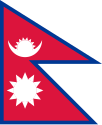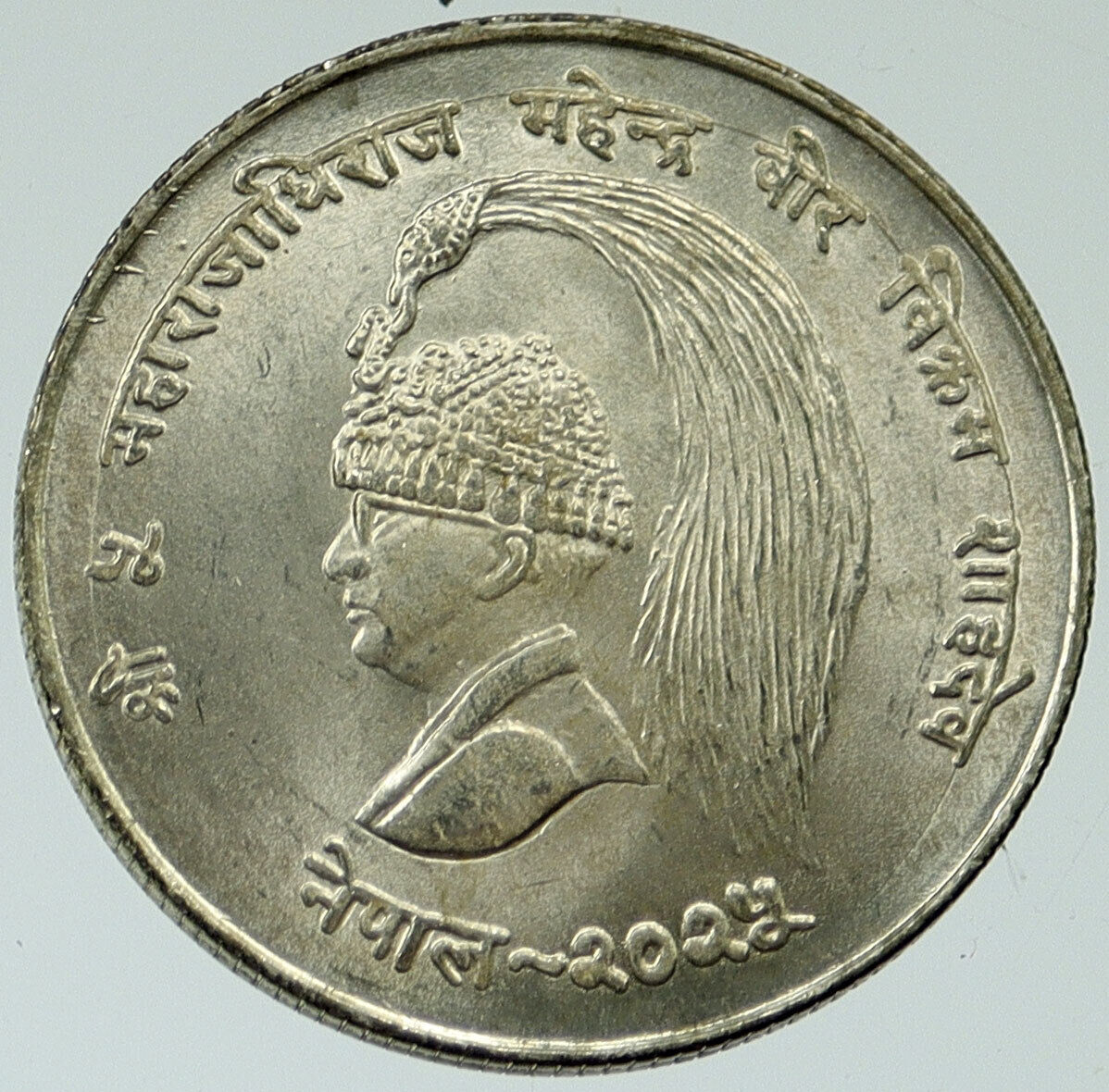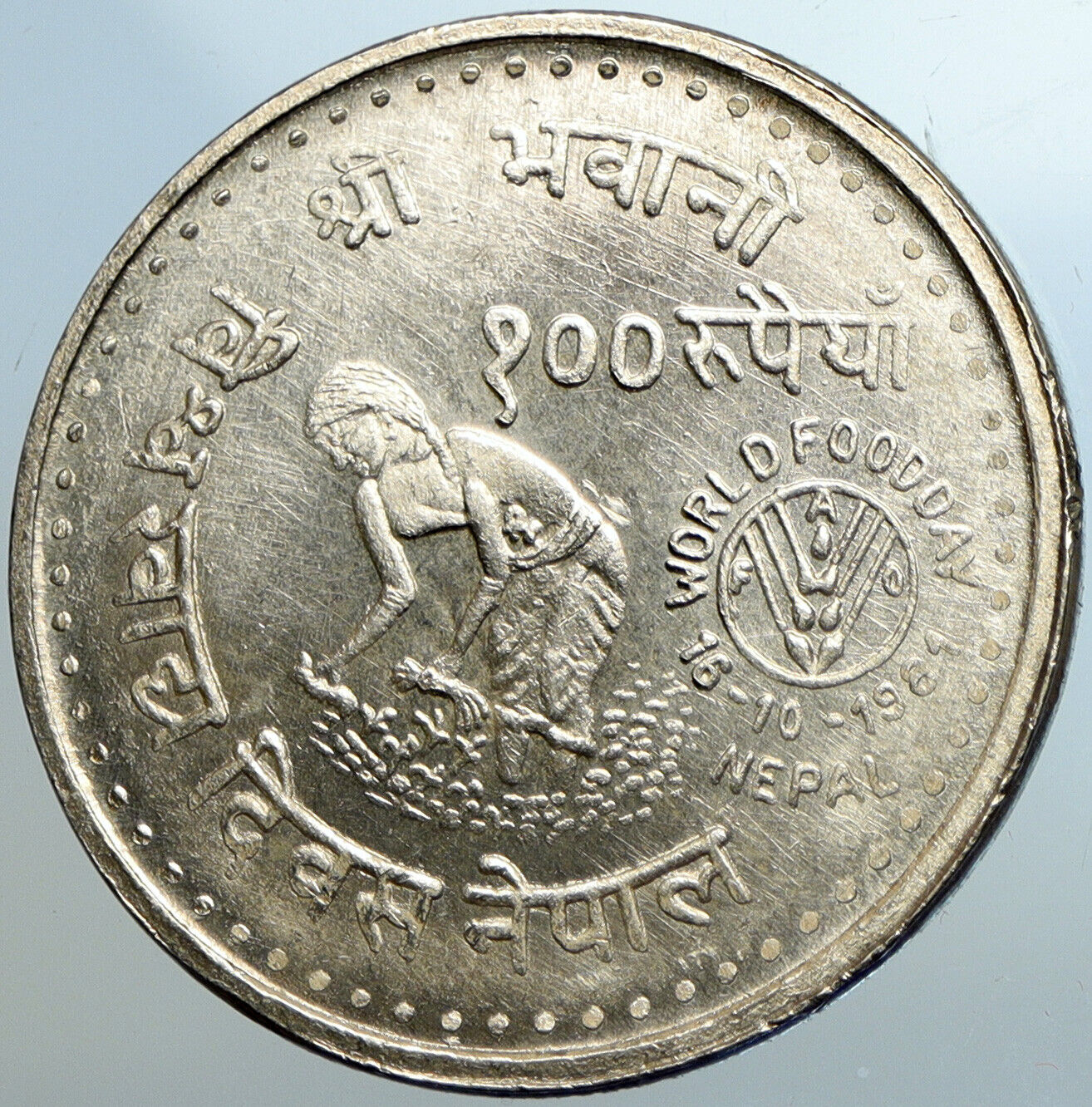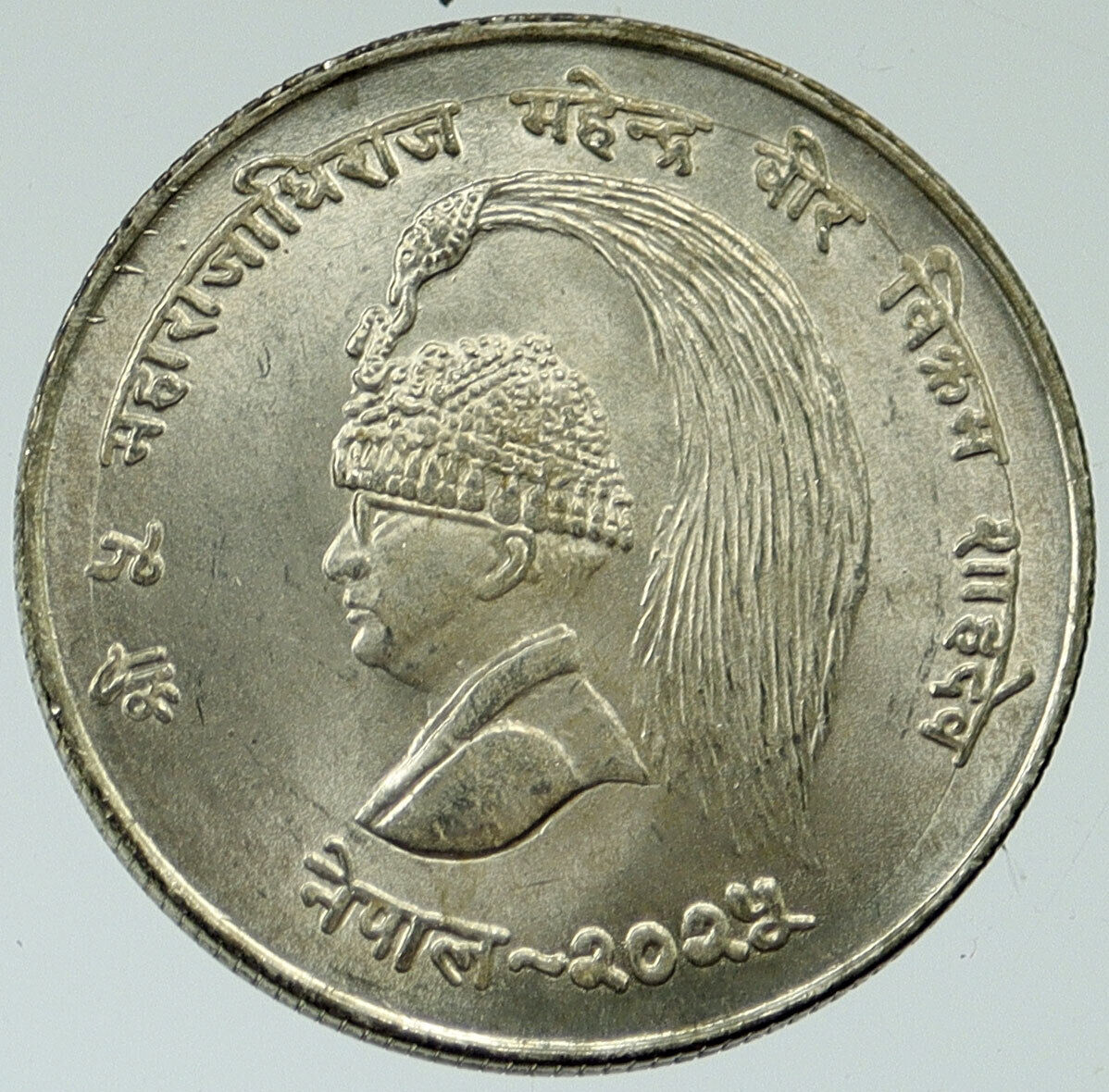|
Nepal under Mahendra Bir Bikram Shah Dev – King: 13 March 1955 – 31 January 1972
Commemorative issue F.A.O.
1968 (2025) Silver 10 Rupees 32mm (15.6 grams) 0.600 Silver (0.3009 oz. ASW)
Referene: KM# 794
Bust of Mahendra Bir Bikram left.
Trident and 1/2 cogwheel above grain sprig.
FOOD FOR ALL 1968 NEPAL below trident; RS 10.
You are bidding on the exact item pictured, provided with a Certificate of Authenticity and Lifetime Guarantee of Authenticity.
 Mahendra Bir Bikram Shah Dev (1 June 1920 – 31 January 1972) was King of Nepal from 1955 to 1972. Mahendra Bir Bikram Shah Dev (1 June 1920 – 31 January 1972) was King of Nepal from 1955 to 1972.
Mahendra was born 11 June 1920 to King Tribhuvan Bir Bikram Shah of Nepal. Although Tribhuvan was nominally king since 1911. Mahendra was captive in Narayanhity Royal Palace, virtually a gilded cage. In 1940 he married Indra Rajya Lakshmi Devi,[5][6] daughter of General Hari Shamsher Rana. They had three sons, Birendra, Gyanendra, Dhirendra and three daughters Shanti, Sharada, and Shobha.[7] Crown Princess Indra died in 1950. In 1952, Mahendra married Indra’s younger sister, Ratna Rajya Lakshmi Devi. This marriage produced no children. Meanwhile, popular discontent and the British withdrawal from India in 1947 had made Rana rule increasingly untenable. In 1950 the political situation had deteriorated so far that the personal safety of the royals was in doubt. Tribhuvan and most of his family escaped to India. Open revolt ensued and by the end of the year the Ranas agreed to a coalition government under Tribhuvan in which they shared power equally with the Nepali Congress Party. By the end of the year the Ranas were manoeuvred out and Nepal’s first experiment with democratic government under constitutional monarchy was underway. Tribhuvan’s health was poor and he died in 1955.[8]
 Nepal, officially the Federal Democratic Republic of Nepal is a landlocked country in South Asia. It is located mainly in the Himalayas but also includes parts of the Indo-Gangetic Plain. With an estimated population of 26.4 million, it is 48th largest country by population and 93rd largest country by area. It borders China in the north and India in the south, east, and west while Bangladesh is located within only 27 km (17 mi) of its southeastern tip and Bhutan is separated from it by the Indian state of Sikkim. Nepal has a diverse geography, including fertile plains, subalpine forested hills, and eight of the world’s ten tallest mountains, including Mount Everest, the highest point on Earth. Kathmandu is the nation’s capital and largest city. Nepal is a multiethnic nation with Nepali as the official language. Nepal, officially the Federal Democratic Republic of Nepal is a landlocked country in South Asia. It is located mainly in the Himalayas but also includes parts of the Indo-Gangetic Plain. With an estimated population of 26.4 million, it is 48th largest country by population and 93rd largest country by area. It borders China in the north and India in the south, east, and west while Bangladesh is located within only 27 km (17 mi) of its southeastern tip and Bhutan is separated from it by the Indian state of Sikkim. Nepal has a diverse geography, including fertile plains, subalpine forested hills, and eight of the world’s ten tallest mountains, including Mount Everest, the highest point on Earth. Kathmandu is the nation’s capital and largest city. Nepal is a multiethnic nation with Nepali as the official language.
 The name “Nepal” is first recorded in texts from the Vedic Age, the era in which Hinduism was founded, the predominant religion of the country. In the middle of the first millennium BCE, Gautama Buddha, the founder of Buddhism, was born in southern Nepal. Parts of northern Nepal were intertwined with the culture of Tibet. The centrally located Kathmandu Valley was the seat of the prosperous Newar confederacy known as Nepal Mandala. The Himalayan branch of the ancient Silk Road was dominated by the valley’s traders. The cosmopolitan region developed distinct traditional art and architecture. By the 18th century, the Gorkha Kingdom achieved the unification of Nepal. The Shah dynasty established the Kingdom of Nepal and later formed an alliance with the British Empire, under its Rana dynasty of premiers. The country was never colonised but served as a buffer state between Imperial China and colonial India. Parliamentary democracy was introduced in 1951, but was twice suspended by Nepalese monarchs, in 1960 and 2005. The Nepalese Civil War in the 1990s and early 2000s resulted in the proclamation of a secular republic in 2008, ending the world’s last Hindu monarchy. The name “Nepal” is first recorded in texts from the Vedic Age, the era in which Hinduism was founded, the predominant religion of the country. In the middle of the first millennium BCE, Gautama Buddha, the founder of Buddhism, was born in southern Nepal. Parts of northern Nepal were intertwined with the culture of Tibet. The centrally located Kathmandu Valley was the seat of the prosperous Newar confederacy known as Nepal Mandala. The Himalayan branch of the ancient Silk Road was dominated by the valley’s traders. The cosmopolitan region developed distinct traditional art and architecture. By the 18th century, the Gorkha Kingdom achieved the unification of Nepal. The Shah dynasty established the Kingdom of Nepal and later formed an alliance with the British Empire, under its Rana dynasty of premiers. The country was never colonised but served as a buffer state between Imperial China and colonial India. Parliamentary democracy was introduced in 1951, but was twice suspended by Nepalese monarchs, in 1960 and 2005. The Nepalese Civil War in the 1990s and early 2000s resulted in the proclamation of a secular republic in 2008, ending the world’s last Hindu monarchy.
.svg/220px-Nepal_(orthographic_projection).svg.png) The Constitution of Nepal, adopted in 2015, establishes Nepal as a federal secular parliamentary republic divided into seven provinces. Nepal was admitted to the United Nations in 1955, and friendship treaties were signed with India in 1950 and the People’s Republic of China in 1960. Nepal hosts the permanent secretariat of the South Asian Association for Regional Cooperation (SAARC), of which it is a founding member. Nepal is also a member of the Non Aligned Movement and the Bay of Bengal Initiative. The military of Nepal is the fifth largest in South Asia; it is notable for its Gurkha history, particularly during the world wars, and has been a significant contributor to United Nations peacekeeping operations. The Constitution of Nepal, adopted in 2015, establishes Nepal as a federal secular parliamentary republic divided into seven provinces. Nepal was admitted to the United Nations in 1955, and friendship treaties were signed with India in 1950 and the People’s Republic of China in 1960. Nepal hosts the permanent secretariat of the South Asian Association for Regional Cooperation (SAARC), of which it is a founding member. Nepal is also a member of the Non Aligned Movement and the Bay of Bengal Initiative. The military of Nepal is the fifth largest in South Asia; it is notable for its Gurkha history, particularly during the world wars, and has been a significant contributor to United Nations peacekeeping operations.
|





 Mahendra Bir Bikram Shah Dev (1 June 1920 – 31 January 1972) was King of Nepal from 1955 to 1972.
Mahendra Bir Bikram Shah Dev (1 June 1920 – 31 January 1972) was King of Nepal from 1955 to 1972.  Nepal, officially the Federal Democratic Republic of Nepal is a landlocked country in South Asia. It is located mainly in the Himalayas but also includes parts of the Indo-Gangetic Plain. With an estimated population of 26.4 million, it is 48th largest country by population and 93rd largest country by area. It borders China in the north and India in the south, east, and west while Bangladesh is located within only 27 km (17 mi) of its southeastern tip and Bhutan is separated from it by the Indian state of Sikkim. Nepal has a diverse geography, including fertile plains, subalpine forested hills, and eight of the world’s ten tallest mountains, including Mount Everest, the highest point on Earth. Kathmandu is the nation’s capital and largest city. Nepal is a multiethnic nation with Nepali as the official language.
Nepal, officially the Federal Democratic Republic of Nepal is a landlocked country in South Asia. It is located mainly in the Himalayas but also includes parts of the Indo-Gangetic Plain. With an estimated population of 26.4 million, it is 48th largest country by population and 93rd largest country by area. It borders China in the north and India in the south, east, and west while Bangladesh is located within only 27 km (17 mi) of its southeastern tip and Bhutan is separated from it by the Indian state of Sikkim. Nepal has a diverse geography, including fertile plains, subalpine forested hills, and eight of the world’s ten tallest mountains, including Mount Everest, the highest point on Earth. Kathmandu is the nation’s capital and largest city. Nepal is a multiethnic nation with Nepali as the official language.  The name “Nepal” is first recorded in texts from the Vedic Age, the era in which Hinduism was founded, the predominant religion of the country. In the middle of the first millennium BCE, Gautama Buddha, the founder of Buddhism, was born in southern Nepal. Parts of northern Nepal were intertwined with the culture of Tibet. The centrally located Kathmandu Valley was the seat of the prosperous Newar confederacy known as Nepal Mandala. The Himalayan branch of the ancient Silk Road was dominated by the valley’s traders. The cosmopolitan region developed distinct traditional art and architecture. By the 18th century, the Gorkha Kingdom achieved the unification of Nepal. The Shah dynasty established the Kingdom of Nepal and later formed an alliance with the British Empire, under its Rana dynasty of premiers. The country was never colonised but served as a buffer state between Imperial China and colonial India. Parliamentary democracy was introduced in 1951, but was twice suspended by Nepalese monarchs, in 1960 and 2005. The Nepalese Civil War in the 1990s and early 2000s resulted in the proclamation of a secular republic in 2008, ending the world’s last Hindu monarchy.
The name “Nepal” is first recorded in texts from the Vedic Age, the era in which Hinduism was founded, the predominant religion of the country. In the middle of the first millennium BCE, Gautama Buddha, the founder of Buddhism, was born in southern Nepal. Parts of northern Nepal were intertwined with the culture of Tibet. The centrally located Kathmandu Valley was the seat of the prosperous Newar confederacy known as Nepal Mandala. The Himalayan branch of the ancient Silk Road was dominated by the valley’s traders. The cosmopolitan region developed distinct traditional art and architecture. By the 18th century, the Gorkha Kingdom achieved the unification of Nepal. The Shah dynasty established the Kingdom of Nepal and later formed an alliance with the British Empire, under its Rana dynasty of premiers. The country was never colonised but served as a buffer state between Imperial China and colonial India. Parliamentary democracy was introduced in 1951, but was twice suspended by Nepalese monarchs, in 1960 and 2005. The Nepalese Civil War in the 1990s and early 2000s resulted in the proclamation of a secular republic in 2008, ending the world’s last Hindu monarchy. .svg/220px-Nepal_(orthographic_projection).svg.png) The Constitution of Nepal, adopted in 2015, establishes Nepal as a federal secular parliamentary republic divided into seven provinces. Nepal was admitted to the United Nations in 1955, and friendship treaties were signed with India in 1950 and the People’s Republic of China in 1960. Nepal hosts the permanent secretariat of the South Asian Association for Regional Cooperation (SAARC), of which it is a founding member. Nepal is also a member of the Non Aligned Movement and the Bay of Bengal Initiative. The military of Nepal is the fifth largest in South Asia; it is notable for its Gurkha history, particularly during the world wars, and has been a significant contributor to United Nations peacekeeping operations.
The Constitution of Nepal, adopted in 2015, establishes Nepal as a federal secular parliamentary republic divided into seven provinces. Nepal was admitted to the United Nations in 1955, and friendship treaties were signed with India in 1950 and the People’s Republic of China in 1960. Nepal hosts the permanent secretariat of the South Asian Association for Regional Cooperation (SAARC), of which it is a founding member. Nepal is also a member of the Non Aligned Movement and the Bay of Bengal Initiative. The military of Nepal is the fifth largest in South Asia; it is notable for its Gurkha history, particularly during the world wars, and has been a significant contributor to United Nations peacekeeping operations. 




